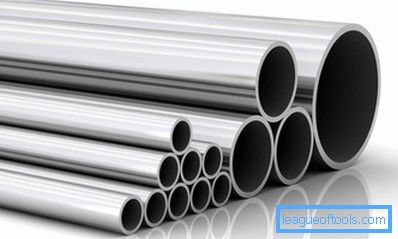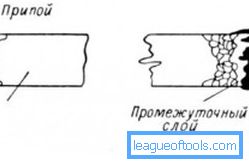How to use solder for stainless steel
It is widely believed that soldering stainless steel is very difficult. But in reality, this material lends itself well to soldering, if the solder for the stainless steel is chosen correctly. Some useful tips also simplify the work. The alloys, called stainless iron, are easy to solder with each other, they are well connected with other metals, for example, with copper and practically any, except for alloys based on aluminum or magnesium.

The stainless steel lends itself well to soldering if the solder for the stainless steel is correctly selected.
Strength and anti-corrosion characteristics allow the use of stainless steels in everyday life and industry is very active. Products are present in the kitchens of each apartment in the same way as in the chemical and other shops of factories. This material is as indispensable as glass and synthetic materials.
Work with stainless steel: preparation of materials
Stainless steel is an alloy of iron, which with frequent contact with water is resistant to corrosion. Processing stainless steel does not cause problems if you have the right set of materials. Tools for this will require the following:
- electric soldering iron;
- gas stove;
- flux;
- solder;
- metal brush;
- solvent;
- soap;
- cloth, rags;
- work gloves.
Selection of materials and tools

Tools for soldering stainless steel: electric soldering iron, gas burner, flux, solder, metal brush, solvent.
An electric soldering iron must have a power of at least 60 W, the optimal value is 100 W, since a low-power one will not heat the part to the required temperature. If you need to put solder on large parts, a more powerful soldering iron is used. It is more convenient and faster to work with a soldering iron, the sting of which is unburned, it is more durable. The technical features of the soldering iron are limited by various circumstances. Only soft and low-melting solders can heat this tool. Details, whose heat sink is very large, it is also problematic to solder them. The temperature of the soldering tip is selected depending on the solder, so that it can be melted. Too much power in the home is not required, as it will only cause energy overruns, and when soldering small parts, overheating can burn them.
It is advisable to purchase such a soldering iron, which has a variable heating level. Such a tool will last longer and will save energy. A soldering iron that has continuous heating, constantly working at maximum power, will fail much faster. His sting breaks off and collapses under the influence of high temperatures for a long time. It is impossible to melt brass with an ordinary soldering iron, for this metal it is required to use a gas torch. Its use greatly complicates the soldering, even if you use a compact type gas cartridge.
Choosing solder, most often masters prefer lead and tin alloy rods.

The order of work when soldering stainless steel.
There is a solder to which cadmium is added. The category of low-melting include zinc-based solders, but they cannot be used with carbon and low-alloy steel, as the adhesion between them is poor and fragile. For stainless steel, solder from pure tin is best suited, and only solder of this type can be used if the sealed place is in contact with food.
When soldering in a dry atmosphere or at the furnace, silver-manganese, chromium-nickel or pure copper solder can be used. A metal such as copper most often has insufficient spreading over the surface, so brass is used to solder copper to a stainless steel. If soldering occurs under corrosive conditions, you can solder with silver tinols with a little nickel added to them.
In addition to solder, flux is also required, the usual rosin is not suitable for soldering steel. This material is good for brazing copper, but for use on stainless steel, the flux must be active. Such fluxes as soldering or phosphoric acid, after application, immediately require to begin work. When, when applied to the place of soldering of a stainless orthophosphoric acid, a lot of time passes, on the surface it forms a phosphate film that makes soldering difficult.
Very often a borax acts as a flux, which is applied with a powder or paste onto a seam. As soon as it is melted, the rest of the material is heated to redness, and upon reaching 850 ° C, the solder is introduced into the seam.
Back to table of contentsHow to solder stainless steel

Technical parameters of soldering stainless pipes.
Parts that require soldering require good cleaning before work, not only from contamination, but also from film of oxides. A metal brush, sandpaper, and grinding wheels can be used for this. After completion of this process, the surface must be degreased with acetone or another solvent. Flux on the places of application of solder is applied in front of it, if you do not use a combined solder, in which the flux is already contained. Soldering stainless steel without flux is difficult, sometimes it requires re-application. This is due to the fact that the metal covers a thin layer of oxide film, which is why the solder does not spread over the surface, but rolls along it, gathering in balls. This makes it very difficult tinning.
In cases where this allows the design of the soldered products, it is more convenient to first solder them separately at the joints, then combine and heat again to the melting temperature. This method gives a very strong connection, even if the first time it does not work out the entire surface of parts. At those places that were left uncovered, the solder is reapplied, again heating it with a soldering iron or a burner, and repeat the procedure until the surface has an even layer of solder.

Phased process of soldering stainless pipes.
In the process of repairing automobile bodies, where they mainly use soldering and iron sheet inlay, they are connected not only by preliminary tinning. It is during these works that solder helps, which already contains a flux. This solder covers one of the contact areas to be soldered, then fix both parts in the clamps and heat the weld area evenly on both sides.
When working with brazing materials that contain brass, a drill is taken as a flux. To melt brass, you need to reach a temperature of 1000 ° C, so the parts need to be warmed up stronger and longer.
Back to table of contentsWork with a gas burner
The parts are heated with a soldered iron tip or gas burner. When working with a burner, it is necessary to ensure that there is not too much oxygen in the flame, as this causes the metal to oxidize. This is determined by the color of the flame (must be blue), if the flame is weak and the color is pale, it indicates an excess of oxygen. To warm up the connection, the burner is moved smoothly.

The scheme of soldering stainless pipes using a gas burner.
Touching the metal with solder periodically, check if the desired temperature has not been reached. Heating can be considered sufficient if the solder does not melt from the fire of the burner, but from touching the metal.
After that, the solder immediately fits into the area where the joint should be, while the parts continue to heat up so that the solder gradually melts and gradually fills the entire joint with itself. If in some place there is not enough liquid solder, it is heated up more than the others, and the solder rushes into it. One of the signs of solid soldering is the leakage of excess solder from the joints.
Back to table of contentsErrors in the soldering process
If during the preparation, selection of materials or in the work made a mistake, the solder may not spread on the metal and not connect the parts. It happens that the parts before work were not cleaned enough or warmed up poorly. Often this happens with large parts. The soldering tip should be cleaned after each session, but in order to maintain the possibility of filigree work, it must be periodically honed.

The scheme of soldering stainless steel hard.
To get a good connection as a result, you should not solder stainless steel with pure lead or choose rosin, and not borax or soldering acid. If tin solder, it is difficult to work with it because of its insufficient consistency. If the tin does not melt more than to a state of soft clay, it is more likely that it will not keep the seam, constantly crumbling and breaking. The correct tin condition for soldering is when it resembles a liquid.
There are alloys with the addition of nickel, which, when heated to 500–700 ° C, begin to emit carbides, and in order to shorten the time of their release, soldering should be carried out as quickly as possible.
Carbides, standing out, significantly reduce the corrosion resistance of stainless steel. In order to nullify the effect of their selection, additional heat treatment is needed at the end of the work.
A good solder, which is laid qualitatively, can only be scratched, but not separated from the place of soldering stainless steel. In order not to spoil, after soldering, the product must be allowed to cool down, without disturbing it at this time. When the seam is cold, it is cleaned of solder and flux remaining on the edges of the seam, it is desirable to wash it with soap and water.
Recommendations, how and what to solder stainless steel, how to choose flux and solder for stainless steel. The main methods of preparing material for work. Soldering stainless steel soldering iron and gas torch.